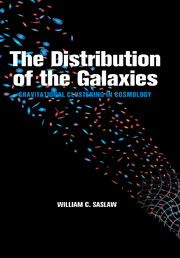Book contents
- Frontmatter
- Contents
- Prologue
- Part I Historical
- Part II Descriptions of Clustering
- Part III Gravity and Correlation Functions
- 16 The Growth of Correlations: I. A Fluid Description
- 17 The Growth of Correlations: II. A Particle Description
- 18 General Correlation Properties
- 19 Computer Simulations
- 20 Simulations and Observations of Two-Particle Correlations
- Part IV Gravity and Distribution Functions
- Part V Computer Experiments for Distribution Functions
- Part VI Observations of Distribution Functions
- Part VII Future Unfoldings
- Bibliography
- Index
20 - Simulations and Observations of Two-Particle Correlations
Published online by Cambridge University Press: 19 January 2010
- Frontmatter
- Contents
- Prologue
- Part I Historical
- Part II Descriptions of Clustering
- Part III Gravity and Correlation Functions
- 16 The Growth of Correlations: I. A Fluid Description
- 17 The Growth of Correlations: II. A Particle Description
- 18 General Correlation Properties
- 19 Computer Simulations
- 20 Simulations and Observations of Two-Particle Correlations
- Part IV Gravity and Distribution Functions
- Part V Computer Experiments for Distribution Functions
- Part VI Observations of Distribution Functions
- Part VII Future Unfoldings
- Bibliography
- Index
Summary
Hundreds of examples of two-point correlations have been published for simulated and observed systems. Here we will stick to the basics. First we see how point masses, each representing a galaxy, can start with a Poisson distribution and then correlate gravitationally for different initial velocity dispersions in universes with different critical densities Ω0. Then I summarize some effects of incorporating a range of galaxy masses, and of other initial distributions, and of intergalactic dark matter.
Originally, astronomers hoped that these sorts of results could be compared directly with observations to read the value of Ω0 off the sky. But it was not to be. Too many ambiguities and combinations of conditions gave similar results for ξ2(r). Current observations are not yet sensitive enough to distinguish among all views of the past. Here I describe just some modern examples of the observed form of ξ2 and consider how they may differ for different types of galaxies.
Simulations
Starting a simulation from a Poisson distribution has the attractive feature of starting with minimum structural information. The initial power spectrum (14.35) has n = 0 and thus there is equal power on all scales: a democratic beginning. Then we can watch how pure gravitational interaction builds up different structures. This approach also helps isolate the effects of more complex initial conditions and processes.
First, we consider a related set of simulations with N = 4,000, values of Ω0 = 1, 0.1, and 0.01, and a Poisson initial spatial distribution.
- Type
- Chapter
- Information
- The Distribution of the GalaxiesGravitational Clustering in Cosmology, pp. 234 - 246Publisher: Cambridge University PressPrint publication year: 1999

